alarm NISSAN NV PASSENGER VAN 2018 Owners Manual
[x] Cancel search | Manufacturer: NISSAN, Model Year: 2018, Model line: NV PASSENGER VAN, Model: NISSAN NV PASSENGER VAN 2018Pages: 426, PDF Size: 4.52 MB
Page 116 of 426
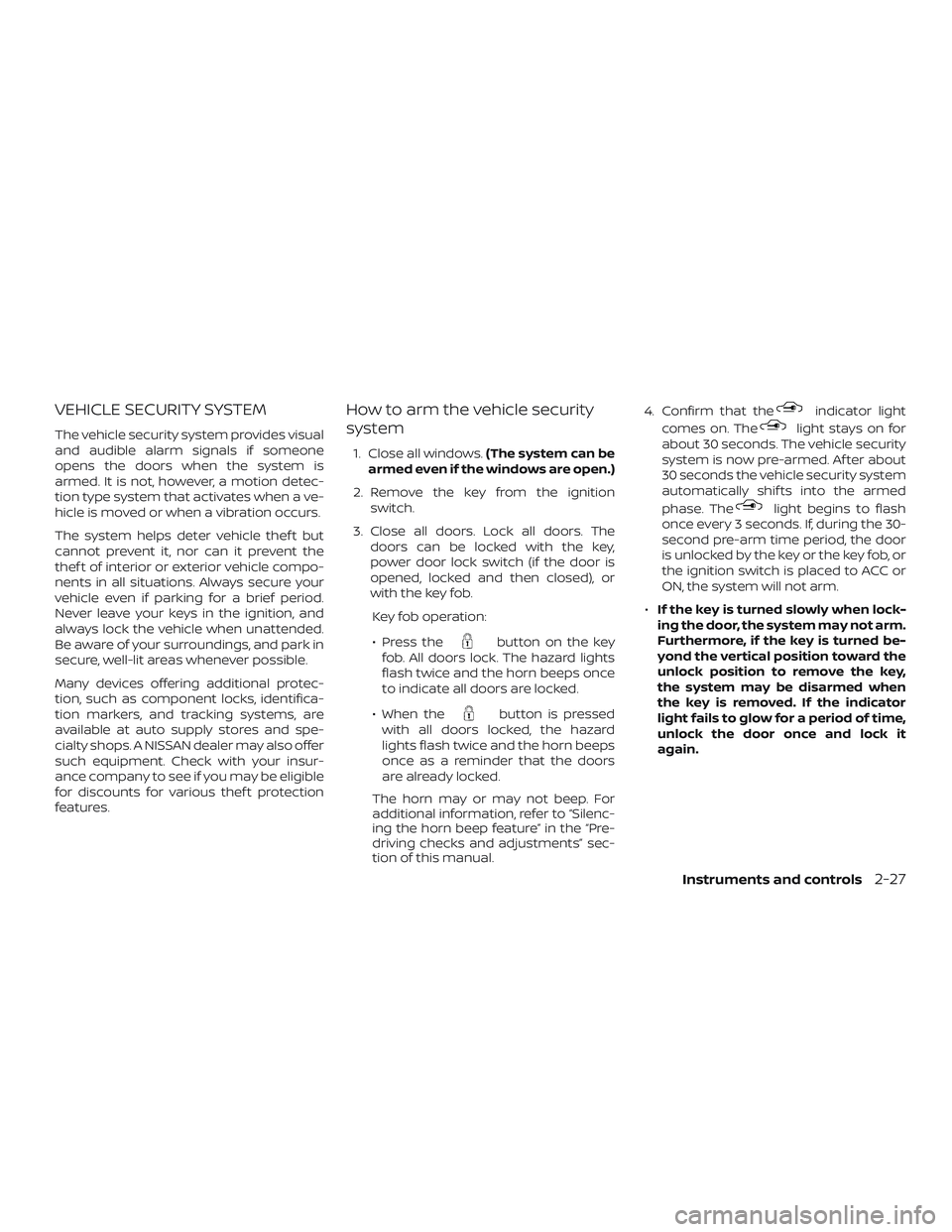
VEHICLE SECURITY SYSTEM
The vehicle security system provides visual
and audible alarm signals if someone
opens the doors when the system is
armed. It is not, however, a motion detec-
tion type system that activates when a ve-
hicle is moved or when a vibration occurs.
The system helps deter vehicle thef t but
cannot prevent it, nor can it prevent the
thef t of interior or exterior vehicle compo-
nents in all situations. Always secure your
vehicle even if parking for a brief period.
Never leave your keys in the ignition, and
always lock the vehicle when unattended.
Be aware of your surroundings, and park in
secure, well-lit areas whenever possible.
Many devices offering additional protec-
tion, such as component locks, identifica-
tion markers, and tracking systems, are
available at auto supply stores and spe-
cialty shops. A NISSAN dealer may also offer
such equipment. Check with your insur-
ance company to see if you may be eligible
for discounts for various thef t protection
features.
How to arm the vehicle security
system
1. Close all windows.(The system can be
armed even if the windows are open.)
2. Remove the key from the ignition switch.
3. Close all doors. Lock all doors. The doors can be locked with the key,
power door lock switch (if the door is
opened, locked and then closed), or
with the key fob.
Key fob operation:
∙ Press the
button on the key
fob. All doors lock. The hazard lights
flash twice and the horn beeps once
to indicate all doors are locked.
∙ When the
button is pressed
with all doors locked, the hazard
lights flash twice and the horn beeps
once as a reminder that the doors
are already locked.
The horn may or may not beep. For
additional information, refer to “Silenc-
ing the horn beep feature” in the “Pre-
driving checks and adjustments” sec-
tion of this manual. 4. Confirm that the
indicator light
comes on. The
light stays on for
about 30 seconds. The vehicle security
system is now pre-armed. Af ter about
30 seconds the vehicle security system
automatically shif ts into the armed
phase. The
light begins to flash
once every 3 seconds. If, during the 30-
second pre-arm time period, the door
is unlocked by the key or the key fob, or
the ignition switch is placed to ACC or
ON, the system will not arm.
∙ If the key is turned slowly when lock-
ing the door, the system may not arm.
Furthermore, if the key is turned be-
yond the vertical position toward the
unlock position to remove the key,
the system may be disarmed when
the key is removed. If the indicator
light fails to glow for a period of time,
unlock the door once and lock it
again.
Instruments and controls2-27
Page 117 of 426

∙Even when the driver and/or passen-
gers are in the vehicle, the system will
arm with all doors closed and locked
with the ignition switch in the OFF po-
sition.
Vehicle security system activation
The vehicle security system will give the
following alarm:
∙ The headlights blink and the horn sounds intermittently.
∙ The alarm automatically turns off af ter a period of time. However, the alarm
reactivates if the vehicle is tampered
with again. The alarm can be shut off by
unlocking the driver’s door with the key
or by pressing the
button on the
key fob.
The alarm is activated by:
∙ opening a door without using the key or key fob (even if the door is unlocked by
using the inside lock knob or the power
door lock switch).
How to stop an activated alarm
The alarm stops only by unlocking the driv-
er’s door with the key or by pressing
the
button on the key fob.
NISSAN VEHICLE IMMOBILIZER
SYSTEM
The NISSAN Vehicle Immobilizer System
will not allow the engine to start without
the use of a registered key.
If the engine fails to start using a registered
key (for example, when interference is
caused by another registered key, an auto-
mated toll road device or automatic pay-
ment device on the key ring), restart the
engine using the following procedures:
1. Leave the ignition switch in the ON po- sition for approximately 5 seconds.
2. Place the ignition switch in the OFF or LOCK position and wait approximately
10 seconds.
3. Repeat steps 1 and 2.
4. Restart the engine while holding the device (which may have caused the in-
terference) separate from the regis-
tered key.
If the no start condition re-occurs, NISSAN
recommends placing the registered key on
a separate key ring to avoid interference
from other devices.
Never leave these keys in the vehicle. FCC Notice:
For USA:
This device complies with Part 15 of the
FCC Rules. Operation is subject to the fol-
lowing two conditions: (1) This device
may not cause harmful interference, and
(2) this device must accept any interfer-
ence received, including interference
that may cause undesired operation.
NOTE:
Changes or modifications not expressly
approved by the party responsible for
compliance could void the user’s author-
ity to operate the equipment.
For Canada:
This device complies with Industry
Canada licence-exempt RSS standard(s).
Operation is subject to the following two
conditions: (1) this device may not cause
interference, and (2) this device must ac-
cept any interference received, including
interference that may cause undesired
operation of the device.
2-28Instruments and controls
Page 152 of 426
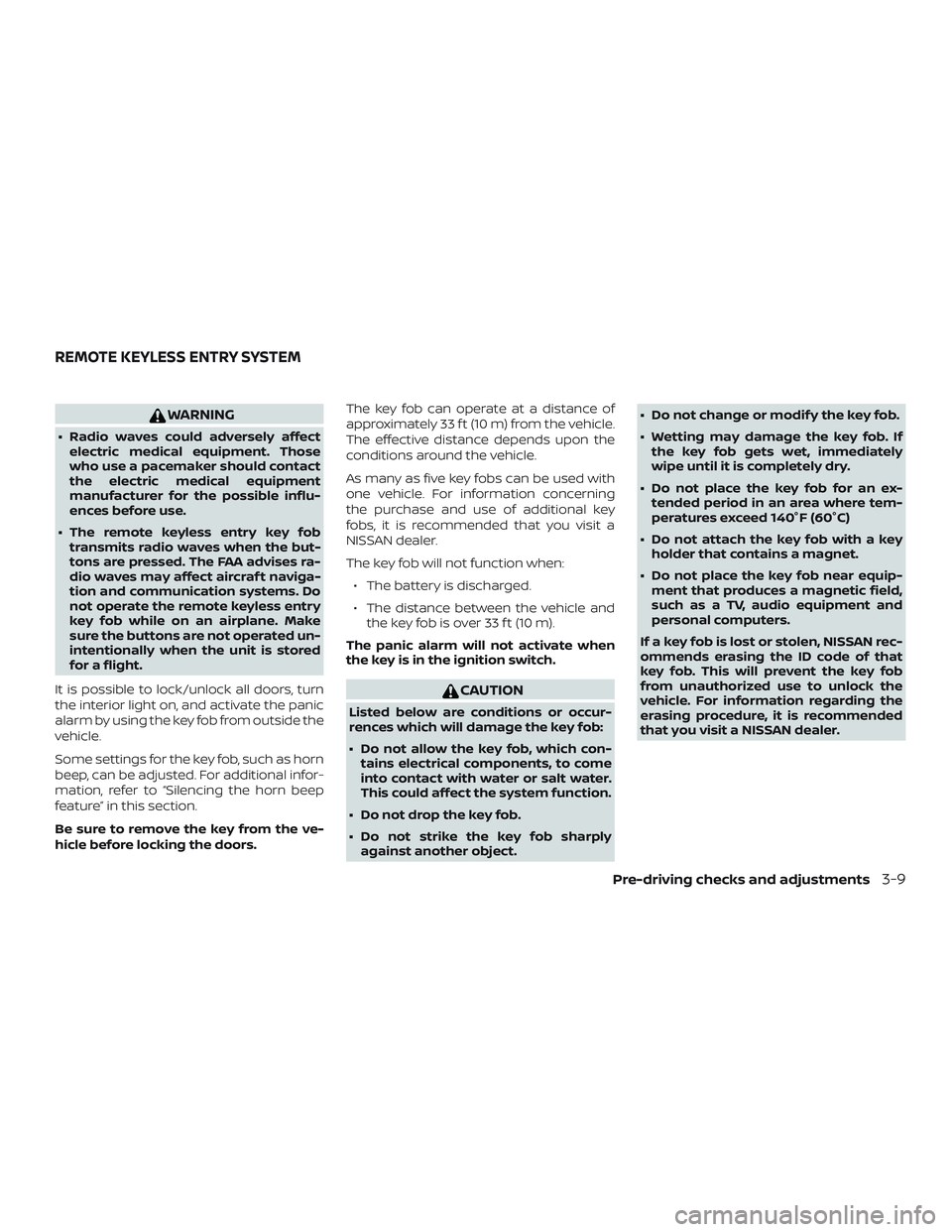
WARNING
∙ Radio waves could adversely affectelectric medical equipment. Those
who use a pacemaker should contact
the electric medical equipment
manufacturer for the possible influ-
ences before use.
∙ The remote keyless entry key fob transmits radio waves when the but-
tons are pressed. The FAA advises ra-
dio waves may affect aircraf t naviga-
tion and communication systems. Do
not operate the remote keyless entry
key fob while on an airplane. Make
sure the buttons are not operated un-
intentionally when the unit is stored
for a flight.
It is possible to lock/unlock all doors, turn
the interior light on, and activate the panic
alarm by using the key fob from outside the
vehicle.
Some settings for the key fob, such as horn
beep, can be adjusted. For additional infor-
mation, refer to “Silencing the horn beep
feature” in this section.
Be sure to remove the key from the ve-
hicle before locking the doors. The key fob can operate at a distance of
approximately 33 f t (10 m) from the vehicle.
The effective distance depends upon the
conditions around the vehicle.
As many as five key fobs can be used with
one vehicle. For information concerning
the purchase and use of additional key
fobs, it is recommended that you visit a
NISSAN dealer.
The key fob will not function when:
∙ The battery is discharged.
∙ The distance between the vehicle and the key fob is over 33 f t (10 m).
The panic alarm will not activate when
the key is in the ignition switch.
CAUTION
Listed below are conditions or occur-
rences which will damage the key fob:
∙ Do not allow the key fob, which con- tains electrical components, to come
into contact with water or salt water.
This could affect the system function.
∙ Do not drop the key fob.
∙ Do not strike the key fob sharply against another object. ∙ Do not change or modif y the key fob.
∙ Wetting may damage the key fob. If
the key fob gets wet, immediately
wipe until it is completely dry.
∙ Do not place the key fob for an ex- tended period in an area where tem-
peratures exceed 140°F (60°C)
∙ Do not attach the key fob with a key holder that contains a magnet.
∙ Do not place the key fob near equip- ment that produces a magnetic field,
such as a TV, audio equipment and
personal computers.
If a key fob is lost or stolen, NISSAN rec-
ommends erasing the ID code of that
key fob. This will prevent the key fob
from unauthorized use to unlock the
vehicle. For information regarding the
erasing procedure, it is recommended
that you visit a NISSAN dealer.
REMOTE KEYLESS ENTRY SYSTEM
Pre-driving checks and adjustments3-9
Page 154 of 426
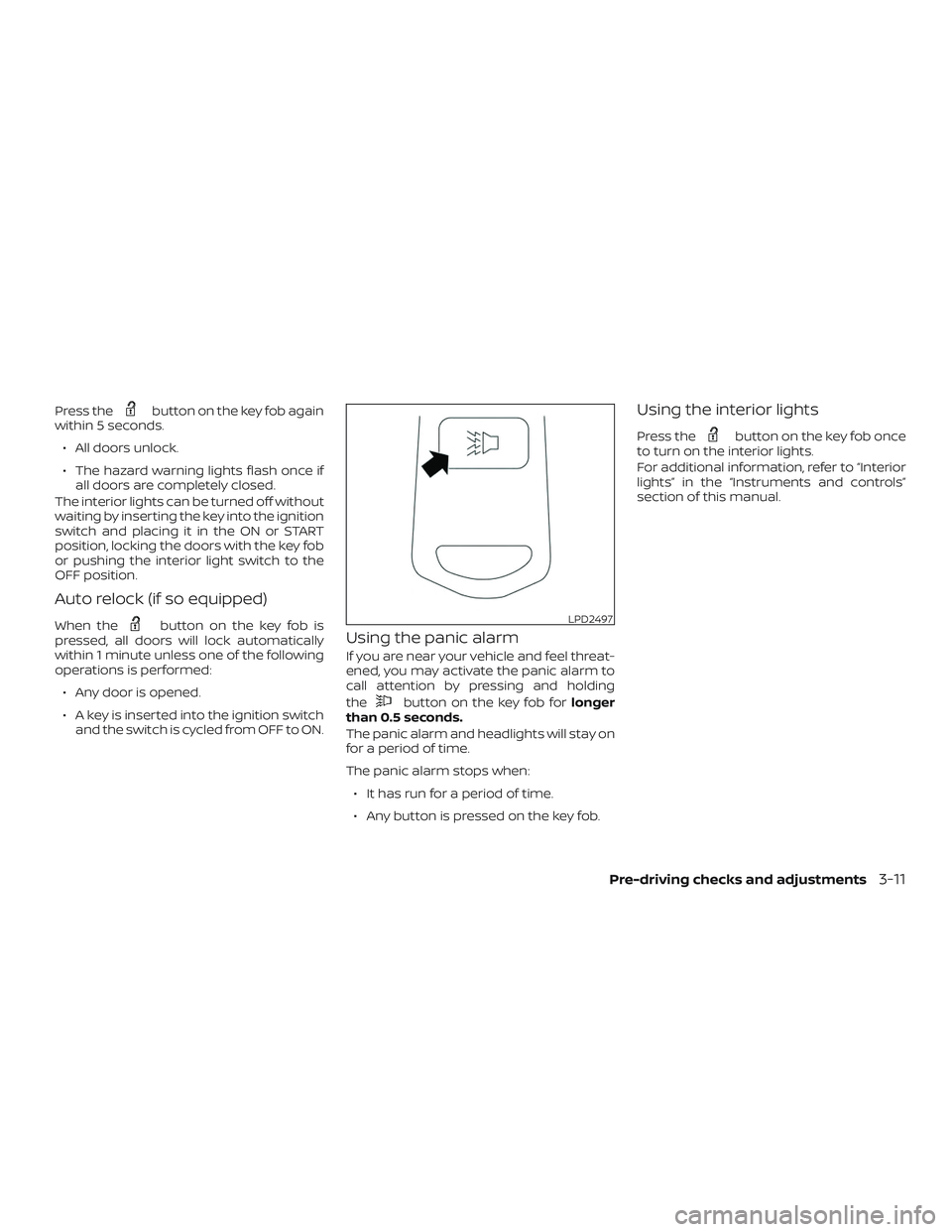
Press thebutton on the key fob again
within 5 seconds.
∙ All doors unlock.
∙ The hazard warning lights flash once if all doors are completely closed.
The interior lights can be turned off without
waiting by inserting the key into the ignition
switch and placing it in the ON or START
position, locking the doors with the key fob
or pushing the interior light switch to the
OFF position.
Auto relock (if so equipped)
When thebutton on the key fob is
pressed, all doors will lock automatically
within 1 minute unless one of the following
operations is performed:
∙ Any door is opened.
∙ A key is inserted into the ignition switch and the switch is cycled from OFF to ON.Using the panic alarm
If you are near your vehicle and feel threat-
ened, you may activate the panic alarm to
call attention by pressing and holding
the
button on the key fob for longer
than 0.5 seconds.
The panic alarm and headlights will stay on
for a period of time.
The panic alarm stops when:
∙ It has run for a period of time.
∙ Any button is pressed on the key fob.
Using the interior lights
Press thebutton on the key fob once
to turn on the interior lights.
For additional information, refer to “Interior
lights” in the “Instruments and controls”
section of this manual.
LPD2497
Pre-driving checks and adjustments3-11
Page 155 of 426

Silencing the horn beep feature
If desired, the horn beep feature can be
deactivated using the key fob.
To deactivate:Press and hold the
andbuttonsfor at least 2 seconds.
The hazard warning lights will flash three
times to confirm that the horn beep fea-
ture has been deactivated.
To activate: Press and hold the
andbuttonsfor at least 2 seconds
once more. The hazard warning lights will flash once
and the horn will sound once to confirm
that the horn beep feature has been reac-
tivated.
Deactivating the horn beep feature does
not silence the horn if the alarm is trig-
gered.
LPD0262
3-12Pre-driving checks and adjustments
Page 293 of 426
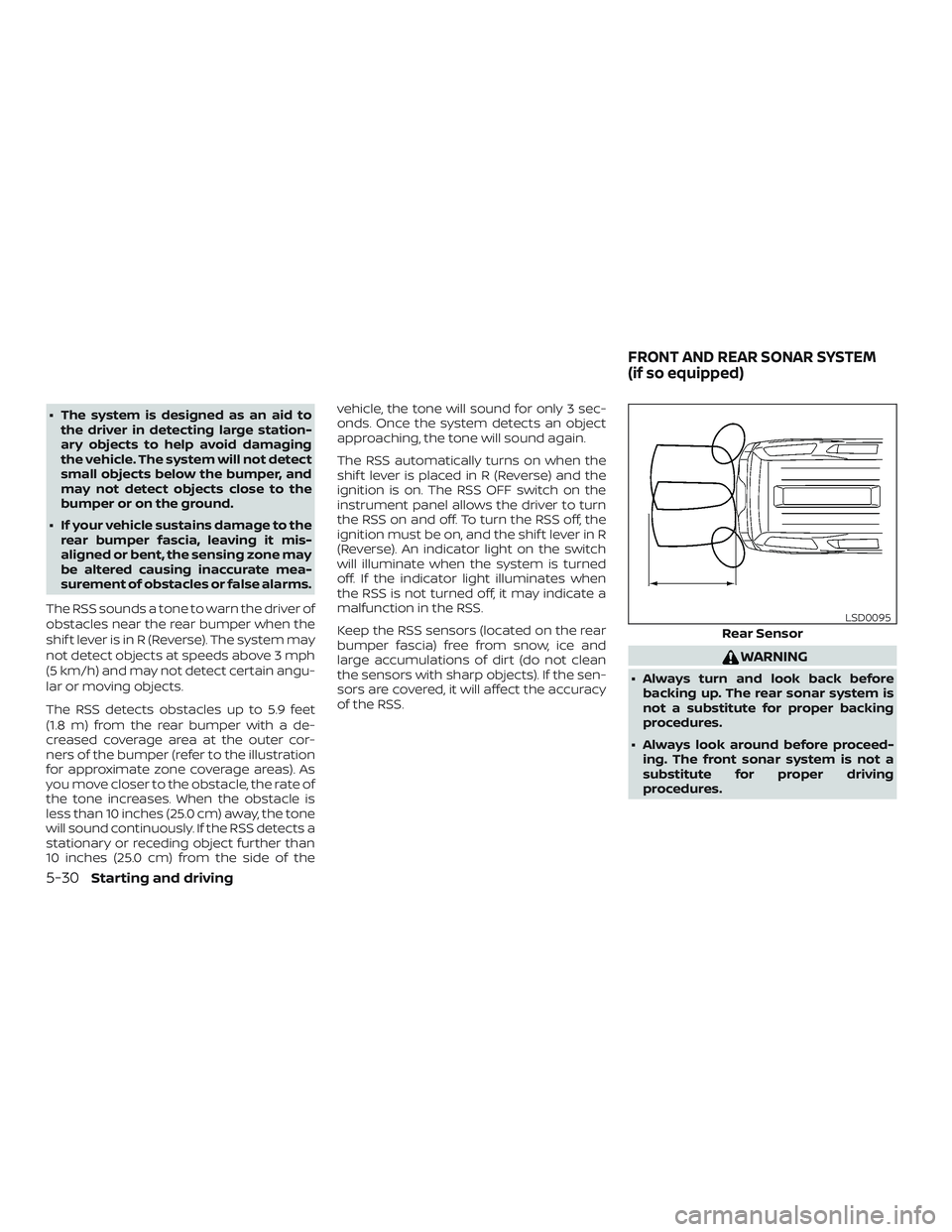
∙ The system is designed as an aid tothe driver in detecting large station-
ary objects to help avoid damaging
the vehicle. The system will not detect
small objects below the bumper, and
may not detect objects close to the
bumper or on the ground.
∙ If your vehicle sustains damage to the rear bumper fascia, leaving it mis-
aligned or bent, the sensing zone may
be altered causing inaccurate mea-
surement of obstacles or false alarms.
The RSS sounds a tone to warn the driver of
obstacles near the rear bumper when the
shif t lever is in R (Reverse). The system may
not detect objects at speeds above 3 mph
(5 km/h) and may not detect certain angu-
lar or moving objects.
The RSS detects obstacles up to 5.9 feet
(1.8 m) from the rear bumper with a de-
creased coverage area at the outer cor-
ners of the bumper (refer to the illustration
for approximate zone coverage areas). As
you move closer to the obstacle, the rate of
the tone increases. When the obstacle is
less than 10 inches (25.0 cm) away, the tone
will sound continuously. If the RSS detects a
stationary or receding object further than
10 inches (25.0 cm) from the side of the vehicle, the tone will sound for only 3 sec-
onds. Once the system detects an object
approaching, the tone will sound again.
The RSS automatically turns on when the
shif t lever is placed in R (Reverse) and the
ignition is on. The RSS OFF switch on the
instrument panel allows the driver to turn
the RSS on and off. To turn the RSS off, the
ignition must be on, and the shif t lever in R
(Reverse). An indicator light on the switch
will illuminate when the system is turned
off. If the indicator light illuminates when
the RSS is not turned off, it may indicate a
malfunction in the RSS.
Keep the RSS sensors (located on the rear
bumper fascia) free from snow, ice and
large accumulations of dirt (do not clean
the sensors with sharp objects). If the sen-
sors are covered, it will affect the accuracy
of the RSS.
WARNING
∙ Always turn and look back before
backing up. The rear sonar system is
not a substitute for proper backing
procedures.
∙ Always look around before proceed- ing. The front sonar system is not a
substitute for proper driving
procedures.
Rear Sensor
LSD0095
FRONT AND REAR SONAR SYSTEM
(if so equipped)
5-30Starting and driving
Page 294 of 426
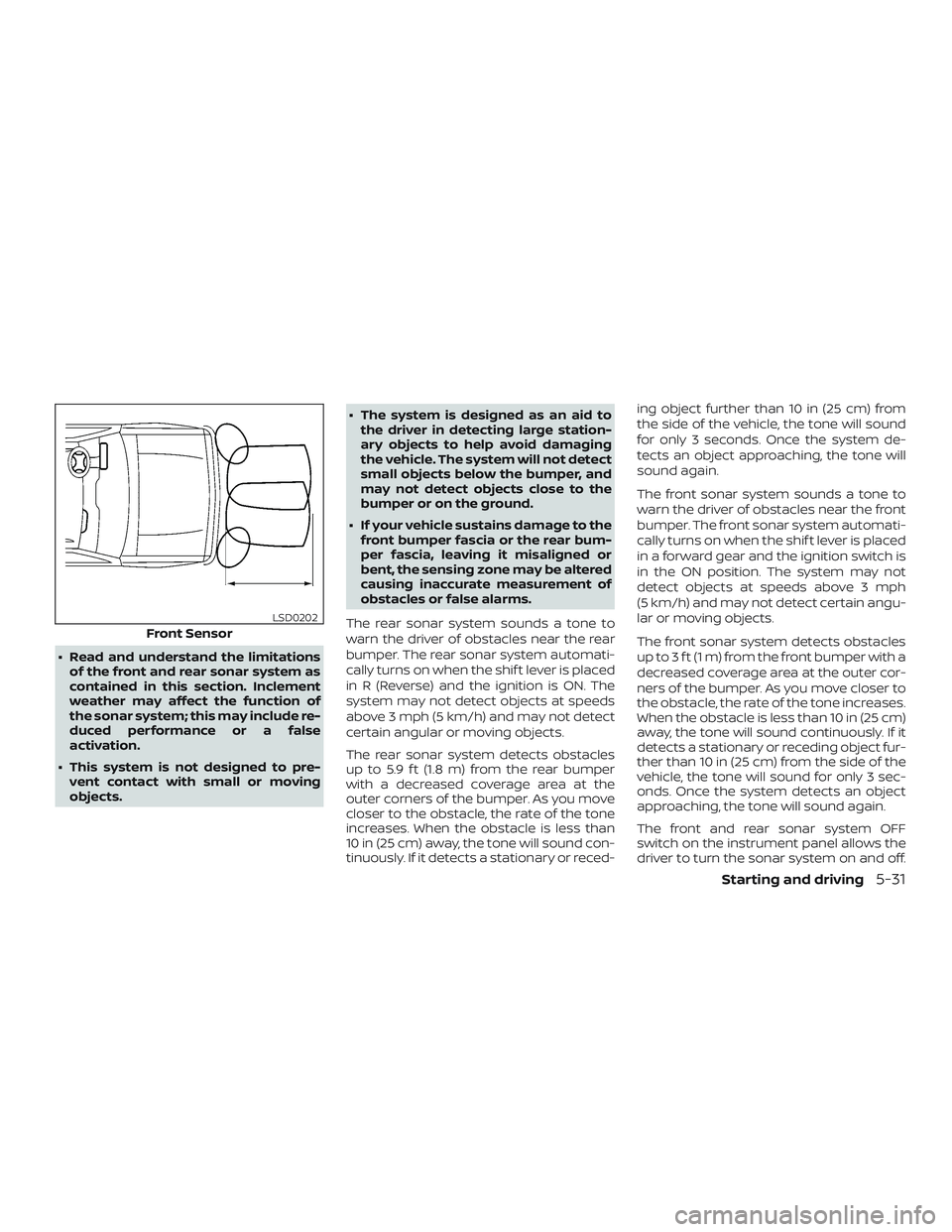
∙ Read and understand the limitationsof the front and rear sonar system as
contained in this section. Inclement
weather may affect the function of
the sonar system; this may include re-
duced performance or a false
activation.
∙ This system is not designed to pre- vent contact with small or moving
objects. ∙ The system is designed as an aid to
the driver in detecting large station-
ary objects to help avoid damaging
the vehicle. The system will not detect
small objects below the bumper, and
may not detect objects close to the
bumper or on the ground.
∙ If your vehicle sustains damage to the front bumper fascia or the rear bum-
per fascia, leaving it misaligned or
bent, the sensing zone may be altered
causing inaccurate measurement of
obstacles or false alarms.
The rear sonar system sounds a tone to
warn the driver of obstacles near the rear
bumper. The rear sonar system automati-
cally turns on when the shif t lever is placed
in R (Reverse) and the ignition is ON. The
system may not detect objects at speeds
above 3 mph (5 km/h) and may not detect
certain angular or moving objects.
The rear sonar system detects obstacles
up to 5.9 f t (1.8 m) from the rear bumper
with a decreased coverage area at the
outer corners of the bumper. As you move
closer to the obstacle, the rate of the tone
increases. When the obstacle is less than
10 in (25 cm) away, the tone will sound con-
tinuously. If it detects a stationary or reced- ing object further than 10 in (25 cm) from
the side of the vehicle, the tone will sound
for only 3 seconds. Once the system de-
tects an object approaching, the tone will
sound again.
The front sonar system sounds a tone to
warn the driver of obstacles near the front
bumper. The front sonar system automati-
cally turns on when the shif t lever is placed
in a forward gear and the ignition switch is
in the ON position. The system may not
detect objects at speeds above 3 mph
(5 km/h) and may not detect certain angu-
lar or moving objects.
The front sonar system detects obstacles
up to 3 f t (1 m) from the front bumper with a
decreased coverage area at the outer cor-
ners of the bumper. As you move closer to
the obstacle, the rate of the tone increases.
When the obstacle is less than 10 in (25 cm)
away, the tone will sound continuously. If it
detects a stationary or receding object fur-
ther than 10 in (25 cm) from the side of the
vehicle, the tone will sound for only 3 sec-
onds. Once the system detects an object
approaching, the tone will sound again.
The front and rear sonar system OFF
switch on the instrument panel allows the
driver to turn the sonar system on and off.
Front Sensor
LSD0202
Starting and driving5-31
Page 418 of 426
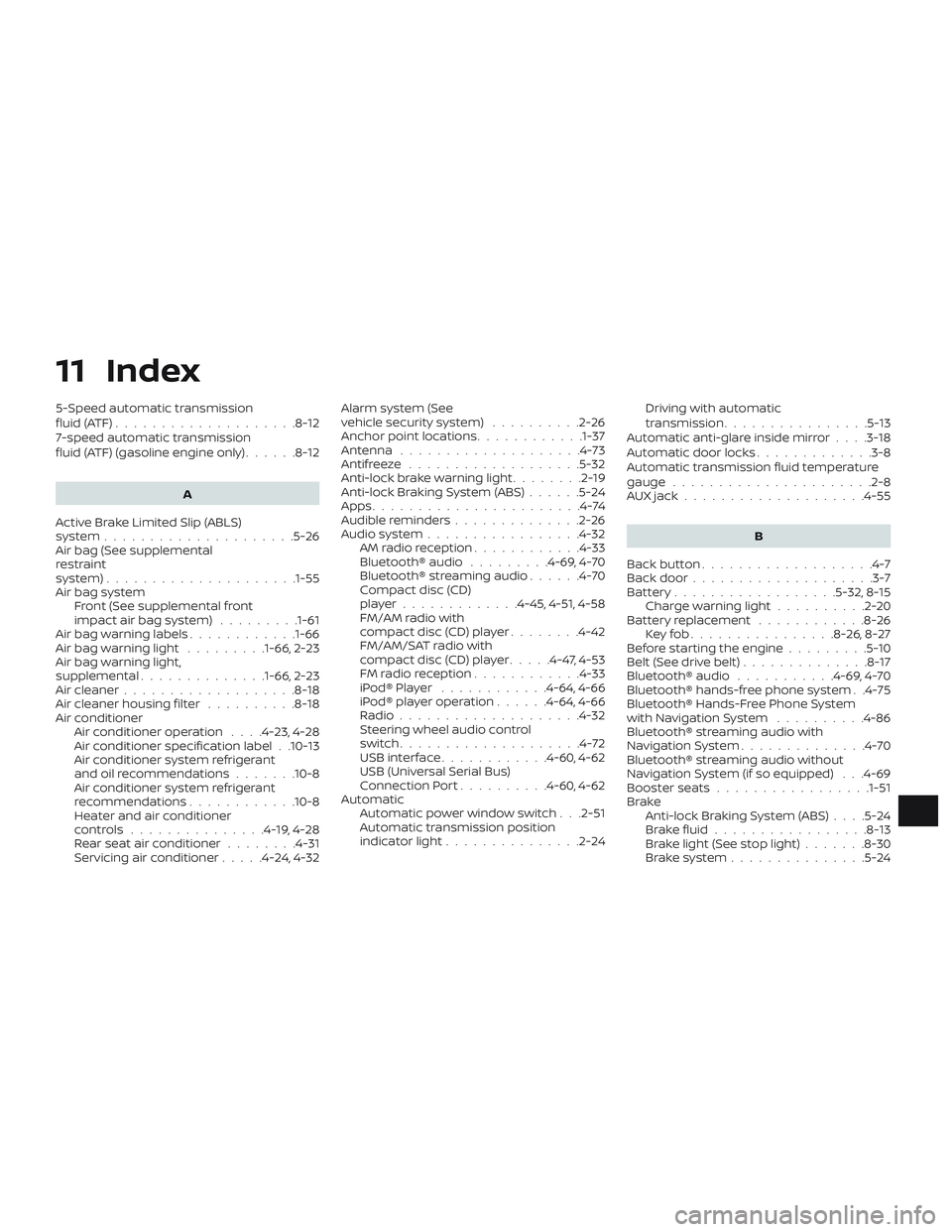
11 Index
5-Speed automatic transmission
fluid(ATF)....................8-12
7-speed automatic transmission
fluid (ATF) (gasoline engine only)......8-12
A
Active Brake Limited Slip (ABLS)
system .....................5-26
Air bag (See supplemental
restraint
system) .................... .1-55
Air bag system Front (See supplemental front
impact air bag system) .........1-61
Air bag warning labels ............1-66
Airbagwarninglight .........1-66, 2-23
Air bag warning light,
supplemental ..............1-66, 2-23
Air cleaner ...................8-18
Air cleaner housing filter ..........8-18
Air conditioner Air conditioner operation ....4-23,4-28
Air conditioner specification label . .10-13
Air conditioner system refrigerant
and oil recommendations .......10-8
Air conditioner system refrigerant
recommendations ............10-8
Heater and air conditioner
controls...............4-19,4-28
Rear seat air conditioner ........4-31
Servicing air conditioner .....4-24,4-32Alarm system (See
vehicle security system)
..........2-26
Anchor point locations ............1-37
Antenna ....................4-73
Antifreeze ...................5-32
Anti-lock brake warning light ........2-19
Anti-lock Braking System (ABS) ......5-24
Apps .......................4-74
Audible reminders ..............2-26
Audiosystem.................4-32 AMradioreception............4-33
Bluetooth® audio .........4-69,4-70
Bluetooth® streaming audio ......4-70
Compact disc (CD)
player.............4-45,4-51,4-58
FM/AM radio with
compact disc (CD) player ........4-42
FM/AM/SAT radio with
compact disc (CD) player .....4-47,4-53
FMradioreception............4-33
iPod®Player ............4-64,4-66
iPod® player operation ......4-64,4-66
Radio ....................4-32
Steering wheel audio control
switch....................4-72
USBinterface............4-60,4-62
USB (Universal Serial Bus)
Connection Port ..........4-60,4-62
Automatic Automatic power window switch . . .2-51
Automatic transmission position
indicatorlight...............2-24 Driving with automatic
transmission................5-13
Automatic anti-glare inside mirror ....3-18
Automatic door locks .............3-8
Automatic transmission fluid temperature
gauge ......................2-8
AUXjack....................4-55
B
Back button ...................4-7
Back door ....................3-7
Battery..................5-32,8-15 Charge warning light ..........2-20
Battery replacement ............8-26
Keyfob................8-26,8-27
Before starting the engine .........5-10
Belt(Seedrivebelt)..............8-17
Bluetooth® audio ...........4-69,4-70
Bluetooth® hands-free phone system . .4-75
Bluetooth® Hands-Free Phone System
withNavigationSystem ..........4-86
Bluetooth® streaming audio with
NavigationSystem..............4-70
Bluetooth® streaming audio without
Navigation System (if so equipped) . . .4-69
Booster seats .................1-51
Brake Anti-lock Braking System (ABS) ....5-24
B
rakefluid.................8-13
Brakelight(Seestoplight).......8-30
Brakesystem...............5-24